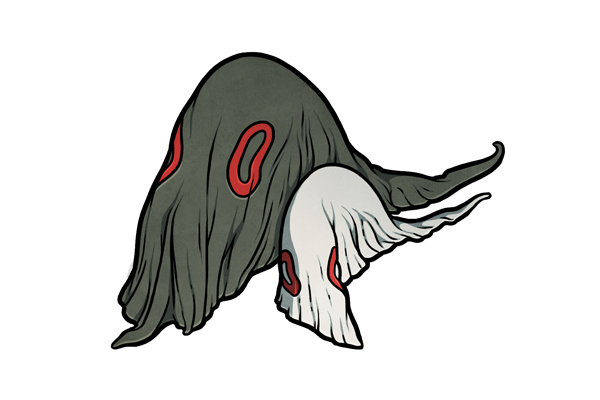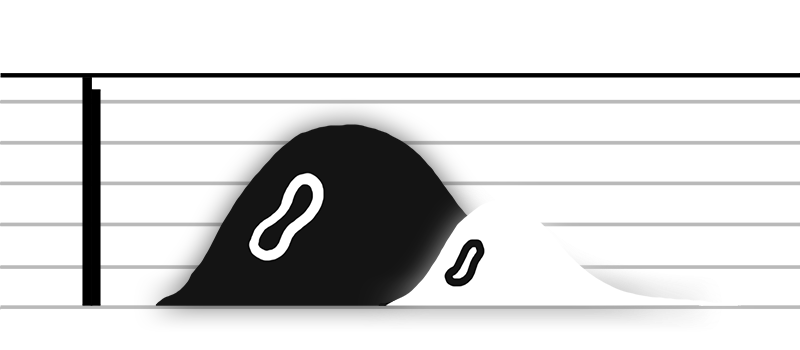

szyszyszkidriski
the reminding storms
prefix szyszyszki suffix driski
exus szyszyszkii
physical appearance
Lacking leg and low in face, the szyszyszkidriski /zaɪˈzɪskəˌdɹɪski/ is a drab-colored stranger composed of a sheet of heavy, canvas-like material. Its surface feels like rubber over canvas; flexible, but hard, and with a greasy sheen across this non-flesh that proves impossible to rub away, but leaves some level of residue behind on that which it touches. Its durable surface resists cutting, and does not regenerate successfully when torn, instead healing in a patchy, fibrous manner, with scar tissue along the edges tending to fray.
Much like the bolo, the szyszyszkidriski's body must maintain contact with the ground at all times. Though it resists being blown away on the wind, it can be yanked upwards via implements such as industrial hooks, poles, or any other object strong enough to support its total weight. The szyszyszkidriski becomes completely inert as soon as contact with the ground ceases.
lesser and greater szyszyszkidriski
The szyszyszkidriski appears in two varieties; one larger, one smaller. The smaller and lighter lesser szyszyszkidriski is the more common of the two, accounting for 87% of individuals, with the darker and larger greater szyszyszkidriski filling the remainder.
The szyszyszkidriski's voice, though abrasive in tone, is easily drowned out by other sounds within its environment. It possesses no language, and instead restricts itself to rattles, snorts, clicks, and grunts.
a grumbling cough, followed by a half-hearted hum.

environment and generation
The szyszyszkidriski generates solely in the presence of sensitives which bear the surname of Szyszyszki. The likeliness of its generation is further exacerbated by boxy, regular buildings of close to three stories in height, with architectural adornment kept to a minimum (when tolerated at all), and litter in abundance. Within these spaces, it appears beneath piles of trash, upturned boxes, small bales of newsprint, and especially piles of dirty cloth. First appearing in a crumpled and pellet-like form, it remains still as it grows, reaching full size within ten minutes and subsequently becoming active.
Groups of szyszyszkidriski generate from single clumps, and pulling themselves apart with strained groans and the creaking of crust-hard fabric.
behaviour and effects
Possessing only a rudimentary emotional disposition, the szyszyszkidriski bands with others of its kind. Groups move in hurried paths throughout their environment, roughly exploratory, but otherwise restraining themselves to fortuitous scrapes. As the edges of their oily bodies brush against hard, immovable objects (such as barrel-edges, the corners of brick-walled buildings, and curb-pipes), this build-up of residue marks the groups' commonly-used paths.
The lesser szyszyszkidriski seems motivated primarily by hunger, and as it roams, it roots along the edges of boxes, beneath dumpsters, and around drainage grates in search of sustenance, with tangles of string and twigs, crumpled receipts (particularly those with handwritten notes on them), and red plastic ribbons among its preferred fodder. It feeds by rising its snout above its source of food and covering them beneath its frame; after much chewing and grunting, it moves on, the object remaining visually untouched, but no longer suitable for further nourishment.
During its foraging, the lesser szyszyszkidriski exhibits marked interest towards clusters of drosodroni and physically similar strains. It rustles with particular delight upon uncovering ragged wads of drosodrouz, which it gobbles up greedily, competition fierce among its companions. Larger and heavier strains, such as the terezorand, appear to confuse the lesser szyszyszkidriski, forcing it to engage in "exponential clustering".
Though it exhibits no visual signs of starvation, the lesser szyszyszkidriski dies when unable to regularly feed.
The greater szyszyszkidriski does not seek out nor require food, and instead moves at the perimeter of its smaller companions, herding when necessary, but otherwise, abstaining from interaction. It keeps as far a distance as possible from other greater szyszyszkidriski, while maintaining its proximity to the mass. Once at an adequate remove, the greater szyszyszkidriski otherwise behaves no differently from the lesser form, and thus acquires a need to feed.
Though wandering, groups of szyszyszkidriski return daily to a specific site (usually an enclosed dead-end or alcove) within which they rest for upwards of several hours, their bodies aligned in rows, no distance left between them.
interactions with sensitives
Just as the szyszyszkidriski restricts its generation to sensitives bearing the the same surname as its prefix, so too does it remain unseen by even the most vigilant sensitive unless within eyeshot of the namebearer.
Though the lesser szyszyszkidriski initially appears unsure how to behave around a sensitive, it takes little time in growing restless, individual responses varying. Some szyszyszkidriski approach sensitives, rooting around the feet or pushing against the ankles, while others become loosely avoidant, hiding their faces behind objects or inside of boxes or side-turned trash cans. Very few display a neutral reaction, with indifferent individuals needing little nudging to join in with the responses of the majority. As time progresses, groups tend to display a unified response.
Greater szyszyszkidriski do not display such hesitation in their behaviors, choosing instead to advance gamely forward, confidently arranging themselves in a circle formation around their namebearer. For both the lesser and greater szyszyszkidriski, this behavior is 99.5% more likely to occur during instances of rain. The more tumultuous the gale or squall, the more likely the szyszyszkidriski will take up formation.
Only during the most jarring of tempests does proximity to the szyszyszkidriski foster vivid recollection of the events丄 of Friday, October 17th,Ꮭ 1976.
After the storm has passed, these formations disband. Any szyszyszkidriski which participated in these formations develop small and fibrous wads of flesh and thread on their underside, with the lesser szyszyszkidriski being more strongly affected, sometimes to the point of disfigurement.
aging and death
Displaying no aging, the szyszyszkidriski's death is instead instantaneous. Its deflated skin flops empty and heavy to the ground, all remaining szyszyszkidriski swarming the corpse. Though its companions initially appear distraught at this sudden change, they calm within the hour to nudge and chew at the resulting skin, which shrinks as its companions feed, the sounds of their chewing filling the air. Once the corpse has been fully eaten, the group moves on, their pursuits yet unreached.



